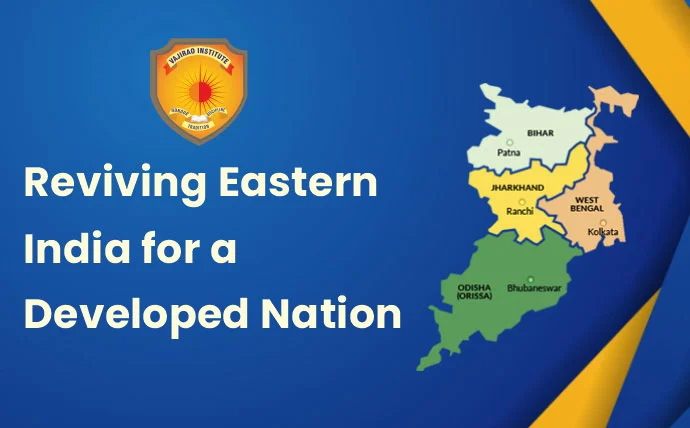
The dreams of a fully developed India by 2047 depend upon not only the cities that bear the population pressure of its western part, but also the plains and the hills of the eastern part. The eastern states of Andhra Pradesh, West Bengal, Odisha, Bihar and Jharkhand are immensely promising but are induces with legacy and geographical condition and socio-economic divisions. In this article, we first examine how these states are organized and the part they have to play in India’s future then we discuss how the latent capability of these states can be unleashed.. Now, let us discuss the states which form this region and their part of India’s developmental story.
- Andhra Pradesh: It is home to, industrial areas such as, Visakhapatnam, and it plays a critical role in the peddling of the Purvodaya plan targets at making the eastern part of the country an economic powerhouse. Some of them are Amritsar-Kolkata Industrial Corridor and Visakhapatnam-Chennai Industrial Corridor that come under the establishment of this framework.
- West Bengal: West Bengal, the birthplace of Rabindranath Tagore, the historic ‘Durga Puja’ and much revered ‘intellectual capital’ is a great combination of tradition and modernity. Kolkata its capital was once home of British colony and even today it is a hub of cultural activity. The state has been located strategically at the Bay of Bengal that makes it to act as hub for trade and commerce.
- Odisha: Maritime history, the city of Puri with the Sun temple in the coastal state of Odisha – Konark and many more things make it quite an interesting state. However, apart from being culturally rich Odisha possesses mineral wealth. Its economy is set to enhance by projects such as the Polavaram Irrigation Project and Visakhapatnam-Chennai Industrial Corridor.
- Bihar:Bihar shares culture and tradition with a historical heritage that has old seats of learning like Nalanda it has a different story all together. This, however, is also a great potential that no other industry has been able to harness before. Capacity enhancement, creation of better infrastructure base and strategic policies alone can steer Bihar back on track.
- Jharkhand: Jharkhand is situated in the eastern part of India on Chota Nagpur Plateau which is endowed with minerals and forests. It is a state that has indigenous abilities within it as well as eyeing industrial progress. The government of India, therefore, through its Purvodaya initiative aims at realizing this potential through the promotion of industrial corridors and sustainable development.
Such states together have provided the foundation of Eastern India’s growth. It is a regional goal that should also be a part of India’s roadmap towards the development by the year 2047.
Challenges imposed by these States from India Being a developed nation.
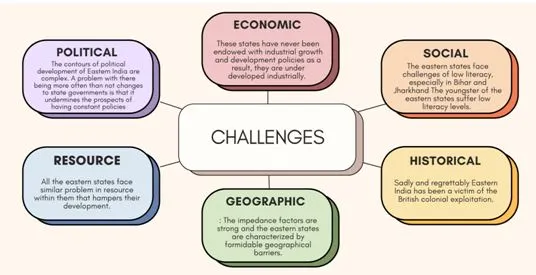
- Political: The contours of political development of Eastern India are complex. A problem with there being more often than not changes to state governments is that it undermines the prospects of having constant policies. Also, competitive federalism where potential richer states attract more investments means that there will be a further increase in the developmental disparity. This is mainly due to corruption and bureaucracy, which still remains as big hurdles toward the development of this region.
- Economic: These states have never been endowed with industrial growth and development policies as a result, they are under developed industrially. This limitation greatly hinders economic growth and development thereby leading to reliance on agriculture and other low paying inconspicuous employment. Also, the Freight Equalisation Policy, introduced in 1952 harmed local industries near minerals by discouraging their development. To realise economic justice for them, it will call for investment and policy interventions.
- Social: The eastern states face challenges of low literacy, especially in Bihar and Jharkhand The youngster of the eastern states suffer low literacy levels. These rates slow down the skill acquisition progress of the populace as well as the available job openings. In the same respect, poverty perpetuity also widens the gap between generations thus limiting the rate of social mobility. To overcome these challenges solutions call for education campaigns and further poverty reduction crusades.
- Historical: Sadly and regrettably Eastern India has been a victim of the British colonial exploitation. These states have played the role of the colony during the colonial time and therefore they lacked a well-developed industrial base. Breaking this historical legacy is going to be possible only through the innovative policies and continuous and persistent efforts towards the growth and development of the region.
- Geographic: The impedance factors are strong and the eastern states are characterized by formidable geographical barriers. These are isolated due to factors such as; sporadic distribution of vegetation covers especially dense forests, difficult terrains and poor access to roads among others. There is limitation in Market access hence limiting integration with the more developed countries. Further, natural calamities which are more frequent in the region including cyclones, floods and droughts are other hindrances to infrastructure advancement and thus, economic growth.
- Resource: All the eastern states face similar problem in resource within them that hampers their development. Lack of funds, little technological resources, and a shortage of qualified manpower are the major challenges. To overcome these challenges, strategic investments, capacity buildings proposals, and innovation are the most effective strategies to unleash the full potential of this region.
How to Overcome these Challenges;
- Streamlined Policies: Streamlining of regulatory procedures and maintaining policies’ harmony may lead to attracting investments.
- Inclusive Governance: This is because it becomes easy to implement development programs, the support given by the local communities, tribal councils, and other autonomous bodies.
- Financial Inclusion: increasing financial literacy and developing the necessary banking networks can help achieve the goal of improving the financial accessibility.
- Renewable Energy: Renewable source such as Hydropower potential that are found in the region have the potential to support sustainable development in energy resource exploitation.
- Tourism: It is also pertinent to mention here that measures like encouraging ecotourism, adventure tourism and cultural tourism could create.
- Quality Education: Extra funding in schools, offering bonuses to teachers to plough back in schools located in hard to reach areas, and community participation in delivery of education will build human capital.
- Skill Training: Employment readiness training that can relate to the forums can encourage the youths and address the existing void.
- Colonial Legacy: If a country recognizes its unjust and exploitative past and concentrates on fair development in the present and the future, the societies can be on harmonious terms.
- Tribal Communities: It helps to address provisions for tribal people in sixth & non-sixth schedule areas in order to involve them in the developmental framework.
- Agriculture: The eastern part of the country is one of the most promising regions to invest on agriculture in the country. This includes adoption of high value crop production, organic agriculture and agro processing which can go along to enhancing incomes and job creation as well.
- Services: In many ways, the sectors such as medical tourism, education industry and IT related services can be used for generation of employment and investment.
- Value Chains: Prospective and encouraging more importance bearing value chains like bamboo based products, spices and handcrafts can assist vulnerable groups like women.
- Cross-Border Connectivity: Improving cross-border routes such as roads and railway and inland waterways improve trade and economic frontier with countries such as Bangladesh, Bhutan, China, Myanmar and Nepal. Some current initiatives such as KM Trevor and IMT are in that direction that an effort should be made towards these directions.
- Urban Transportation: Integrated and effective system’s establishment for transportation in the urban areas can enhance the connectivity.
Government Initiatives to overcome these Challenges:
- Purvodaya project: To a large extent, the Purvodaya project that was presented in the Budget 2024-25 seeks to transform the eastern region states into growth poles of the nation. This relates to the sectors of Industrialization, Infrastructure Development, Skills Development and Poverty Reduction.
- National Infrastructure Pipeline: or NIP as it is commonly known is a document that details the development and management of the country’s infrastructure. The development will have significant impact on Eastern India especially in relation to the connectivity and jobs which will be generated.
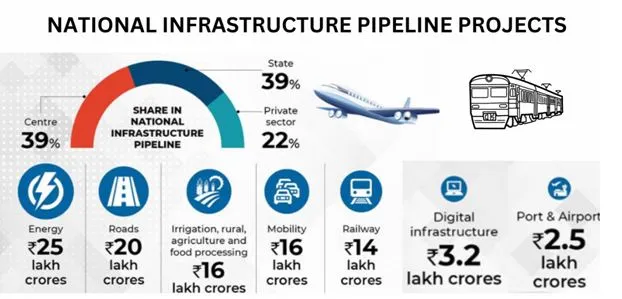
- Self-reliant India Mission: In this case it means that only preserving its own resources and pushing for the development of local industries Eastern India can come up with more efficient ways of strengthening the national economy.
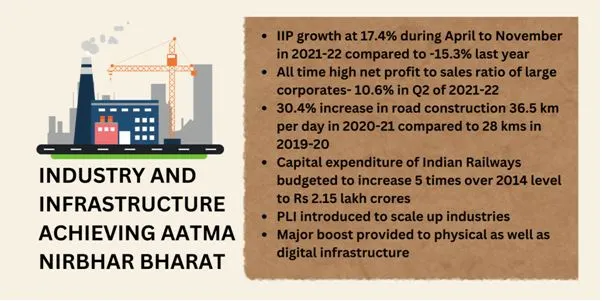
- Emphasize Sustainable Growth: Sustainable development has been used in the efforts of increasing economic growth especially in the areas of agriculture, tourism, and other infrastructure.
- Inclusive Governance and Local Participation: The problem with most development issues is that when the local communities are involved in decisions, and then there is efficient implementation of the projects. Increased independence of the bodies and councils of tribes can positively affect the enhancement of the administration.
- Social segregation: it can be ameliorated by accepting the differing effects of colonialism on certain areas which in development should be given equal valance. Concerning the deficiency of the laws targeting provisions to spare tribal communities’ part of development.
What should be the Strategy for the Development?
- Infrastructure Investment: Improve the transportation systems, energy sources and industrial areas. Construct facilities such as ports to facilitate exchange within the region and other parts of the country ease construction of rail-road networks and asphalted roads.
- Skill Development and Education: To implement human capital formation, one needs to give an emphasis to vocational training and education for the workers. This enables to close the gap existing between skills and competence and achieve the aim of local needs.
- Targeted Policies: Ensure that policies that are being put in place addresses the challenges that exist in the specific region. Support the export-oriented agro based industries, tourism and environmental conservation.
- Disaster Preparedness: Development of EC projects also help to build up sufficient measures against natural Disaster threats such as cyclones and floods etc. One must invest in early warning system and protective structures for infrastructures.
- Stable Governance and Inclusive Growth: Policies and forward investment are important to stay constant so that the success of the country is sustainable. Involving the locals can be a must include strategy to ease growth in the part of country.
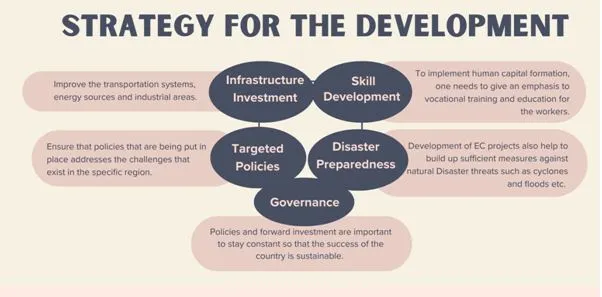
In the green fields of the East there is a potential of unknown size, a part of India waiting to be born. Like stars behind the darkness of night, Eastern India possesses enormous potentialities which are still unrecognized, which can be activated by investing in physical facilities, by developing the capabilities of people, and by preparing relevant policies and programmes. On the lands served by the dawn of the sun over the Bay of Bengal, let us think about a colourful future of a living syncretic destiny of East of India for the Development.